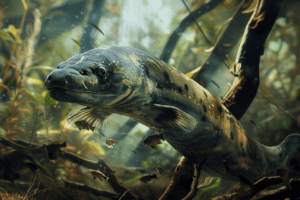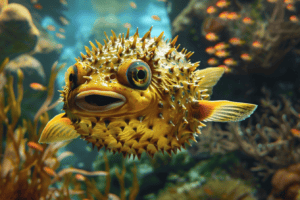The Mandarin fish, also known as the psychedelic fish, is a small, brightly colored fish found in the Pacific and Indian Oceans.
Its vibrant hues and intricate patterns make it a popular choice for aquarium enthusiasts.
However, there is much more to this fish than just its stunning appearance.

The Mandarin fish belongs to the dragonet family, which is known for its unique features such as the ability to change color and shape.
The Mandarin fish, in particular, is famous for its psychedelic appearance, which is caused by its intricate coloration and patterns.
Its body is covered in a kaleidoscope of colors, including orange, blue, green, and purple, which blend together to create a mesmerizing effect.
Despite its popularity in the aquarium trade, the Mandarin fish is relatively unknown outside of the fishkeeping community.
This article aims to shed some light on the fascinating world of the Mandarin fish, exploring its behavior, habitat, and unique features.
So, let’s dive in and discover the psychedelic world of the Mandarin fish.
Mysteries of the Mandarin Fish
The Mandarin Fish is a fascinating creature that has captured the attention of many marine enthusiasts.
This fish is known for its vibrant and colorful patterns that make it stand out from other fish species.
However, there is more to the Mandarin Fish than just its striking appearance.
In this section, we will explore some of the mysteries surrounding this unique fish.
Vibrant Patterns
One of the most striking features of the Mandarin Fish is its vibrant and colorful patterns.
These patterns are not just for show, but they serve a purpose.
The Mandarin Fish uses its bright colors to attract potential mates and to deter predators.
The patterns on its body are unique to each individual fish, making them easily identifiable.
Interestingly, the Mandarin Fish does not have any scales.
Instead, its body is covered in a layer of mucus that protects it from parasites and other harmful organisms.
This mucus layer also helps to enhance the fish’s colors, making them appear even more vibrant.
Habitat and Distribution
The Mandarin Fish is native to the Pacific Ocean, specifically in the waters surrounding Japan, Taiwan, and the Philippines.
It is typically found in shallow coral reefs and lagoons, where it can hide among the coral and other marine life.
Despite its popularity among aquarium enthusiasts, the Mandarin Fish is not a common sight in the wild.
Its small size and elusive nature make it difficult to spot, and its habitat is under threat due to climate change and human activity.
In conclusion, the Mandarin Fish is a fascinating creature that has many mysteries surrounding it.
Its vibrant patterns and unique characteristics make it a popular subject among marine enthusiasts.
However, its habitat is under threat, and more research is needed to understand and protect this beautiful fish.
The Diet of a Colorful Carnivore

The Mandarin Fish is a carnivorous creature that feeds on a variety of small marine animals.
While they are known for their vibrant colors and unique appearance, their diet is equally fascinating.
Hunting Tactics
The Mandarin Fish is a skilled hunter, using its excellent eyesight and camouflage to stalk prey.
It is known to hide in crevices and wait for unsuspecting prey to swim by.
Once it spots a potential meal, it will dart out and grab it with lightning-fast reflexes.
Preferred Prey
The Mandarin Fish has a diverse diet, feeding on a range of small marine animals such as crustaceans, mollusks, and small fish.
They are particularly fond of bristle worms, copepods, and isopods.
These creatures are often found in the crevices and cracks of coral reefs, where the Mandarin Fish likes to hunt.
Interestingly, the Mandarin Fish is known to be a picky eater.
They have been observed to ignore certain types of food, even when they are readily available.
This suggests that they have a highly refined sense of taste and are able to distinguish between different types of prey.
In conclusion, the Mandarin Fish is a fascinating creature with a unique diet.
Its hunting tactics and preference for certain types of prey make it a fascinating subject for marine biologists and nature enthusiasts alike.
Reproduction and Lifecycle

Mating Rituals
The Mandarin fish is known for its striking colors and unique mating rituals.
During mating season, males will display their vivid colors by spreading their fins and swimming in a zigzag motion.
This is to attract females and to establish dominance over other males.
Once a female is interested, the male will lead her to a suitable location for spawning.
The spawning process involves the female laying her eggs and the male fertilizing them.
The eggs are then left to develop on their own, with no parental care provided.
It is important to note that Mandarin fish are not monogamous and will mate with multiple partners during the mating season.
Growth Stages
After hatching, the larvae are tiny and transparent, making them difficult to spot in the wild.
As they grow, their colors become more vibrant and distinct.
At around 6 months old, the fish reach sexual maturity and are able to reproduce.
Mandarin fish have a lifespan of around 3 to 5 years in the wild. However, in captivity, they can live up to 10 years with proper care.
It is important to note that the survival rate of Mandarin fish larvae is relatively low, with only a small percentage surviving to adulthood.
In conclusion, the reproductive and lifecycle of the Mandarin fish is fascinating and unique.
From their colorful mating rituals to their growth stages, these fish have captivated the attention of scientists and aquarium enthusiasts alike.
By learning more about their lifecycle, we can gain a greater appreciation for these beautiful and elusive creatures.
Conservation Status

Environmental Threats
The Mandarin Fish is a species that is currently listed as Near Threatened on the International Union for Conservation of Nature (IUCN) Red List.
The primary environmental threat to the Mandarin Fish is habitat loss and degradation.
The species inhabits coral reefs, which are among the most diverse ecosystems on the planet, but are under threat from a range of human activities.
These include overfishing, pollution, and climate change, which can cause coral bleaching, leading to the death of coral reefs.
In addition to habitat loss, the Mandarin Fish is also threatened by the aquarium trade.
The species is highly prized by aquarium enthusiasts due to its striking appearance, and as a result, it is heavily targeted for collection.
This can have a significant impact on wild populations, and can also lead to the spread of diseases and parasites.
Conservation Efforts
Efforts to conserve the Mandarin Fish are ongoing, and include a range of initiatives aimed at protecting its habitat and reducing the impact of the aquarium trade.
One approach is the establishment of marine protected areas, which can help to safeguard coral reefs and the species that depend on them.
In addition, efforts are underway to reduce overfishing and to promote sustainable fishing practices.
Another important conservation effort is the development of captive breeding programs for the Mandarin Fish.
These programs can help to reduce the demand for wild-caught specimens, and can also provide a source of fish for release into the wild.
In addition, captive breeding can help to improve our understanding of the species, and can provide insights into its biology and behavior.
Overall, the conservation status of the Mandarin Fish remains a concern, and ongoing efforts are needed to protect this unique and fascinating species.
By working together, we can help to ensure that the Mandarin Fish and other coral reef species continue to thrive for generations to come.
Frequently Asked Questions

How does the mandarin fish get its vibrant colors?
The mandarin fish is known for its vibrant and striking colors, which make it one of the most beautiful fish in the world.
The bright blue, green, orange, and red colors are not the result of pigments, but rather the result of structural coloration.
The scales of the mandarin fish contain microscopic ridges that reflect light in a way that creates the bright colors that we see.
What habitats are essential for the survival of mandarin fish?
Mandarin fish are native to the Pacific Ocean, particularly in the waters around Indonesia, Australia, and the Philippines.
They are found in coral reefs and lagoons, where they can hide among the coral and rocks.
These habitats provide the mandarin fish with shelter, food, and a place to breed.
Can you explain the diet of a mandarin fish?
The mandarin fish is a carnivorous species that feeds on small invertebrates, such as crustaceans, mollusks, and worms.
They are also known to eat small fish and plankton. Mandarin fish have a small mouth and no teeth, so they swallow their prey whole.
What unique behaviors do mandarin fish exhibit?
Mandarin fish are known for their unique mating behavior.
During the breeding season, the male mandarin fish will perform a courtship dance to attract a female.
The dance involves swimming around the female, flashing his colorful fins, and making clicking noises.
Once the female is ready to mate, the male will release his sperm into the water, and the female will release her eggs.
The eggs will then be fertilized in the water.
How does the mandarin fish interact with other species in its environment?
Mandarin fish are a peaceful species and do not exhibit aggressive behavior towards other fish.
They are often preyed upon by larger fish, such as groupers and lionfish.
However, they have developed unique adaptations to survive in their environment, such as their bright colors, which help them blend in with the coral and rocks.
What are the conservation concerns surrounding mandarin fish?
Mandarin fish are a popular species in the aquarium trade, which has led to overfishing in some areas.
They are also threatened by habitat destruction, pollution, and climate change.
Conservation efforts are underway to protect the mandarin fish and their habitat, including the establishment of marine protected areas and sustainable fishing practices.









